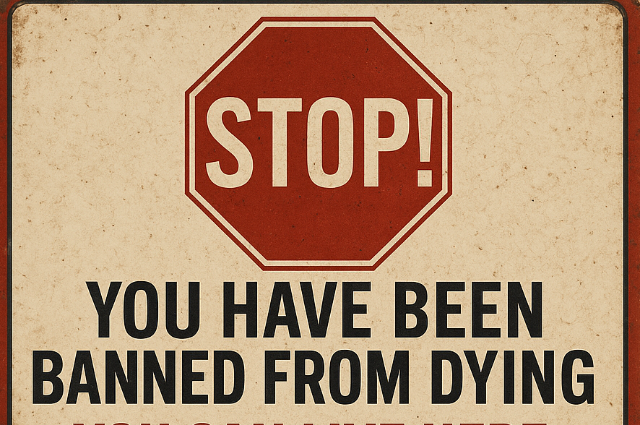
Imagine collapsing on the road, your heart beating fast, vision going off, and as you struggle to breathe, a police officer rushes over… not to save you, but to punish you with a fine or take you to jail. Sounds absurd? Crazy? Maybe... No comments at all!
Well, we humans have had a fantastic history of creating both the harshest and the most ridiculous laws of all time. But again, these laws had or have both practical and symbolic reasons. There are places in the world where death is not allowed. Some have run out of space for graves, some want to keep their land pure, while there are some whose frozen grounds won’t let bodies decompose at all.
Let’s have a look at the towns that said to death, ‘Not Today!’
Dead End: When Towns Ran Out of Room for the Dead
- Lanjarón (Spain)
In 1999, the mayor of Lanjarón, a small town in southern Spain, made it illegal to die in the town. While it sounds like satire, the reason was real, the local cemetery was full, and the government hadn’t approved land for a new one. The mayor’s move was part protest, part publicity stunt, and entirely absurd, with residents advised to stay alive until further notice!
2. Le Lavandou (France)
This beach town on the French Riviera faced a grim problem in 2000, no more burial plots left in the town! After repeated requests to build a new cemetery were denied due to environmental concerns, Mayor Gil Bernardi passed a bylaw forbidding death. He called it “an absurd law to counter an absurd situation.”
3. Cugnaux (France)
In 2007, the mayor of Cugnaux, a town in southwest France, did a similar thing. After being denied permission to expand the local cemetery, he issued a decree banning death. The move was symbolic, but effective. The government eventually allowed the cemetery to grow. Sometimes, it seems, you have to outlaw the inevitable to get anything done!
4. Biritiba Mirim (Brazil)
In 2005, the mayor of Biritiba Mirim, a town near São Paulo, proposed a law making it illegal to die. The cemetery had reached capacity, over 50,000 people buried in just 3,500 crypts and environmental laws blocked any expansion. The mayor even suggested punishing the families of those who died! While the law was never passed, it was a bold protest against red tape that left the town with nowhere to bury its dead.
Holy Land, Frozen Land: Where Dying Just Doesn’t Work
1. Itsukushima (Japan)
Also known as Miyajima, this island is home to the famous floating torii gate and the sacred Itsukushima Shrine, a UNESCO World Heritage Site. In Shinto belief, purity is everything, and death (along with birth) is seen as a form of pollution. To protect the spiritual sanctity of the island, no one is allowed to die or give birth there. Since 1878, pregnant women and the terminally ill have been expected to leave the island before their time comes. There are no cemeteries or hospitals on Itsukushima, and even after a 16th-century battle took place there, the victorious commander had the battlefield scrubbed clean and the bodies removed to the mainland to restore the island’s purity!
2. Delos (Greece)
In ancient Greece, the island of Delos was considered the birthplace of Apollo and Artemis, making it one of the holiest sites in the Aegean. To preserve its divine purity, death and birth were banned as early as the 6th century BCE. Graves were relocated, and by the 5th century BCE, under orders from the Delphic Oracle, the island was fully purified. Anyone nearing death or childbirth was required to leave the island immediately.
3. Longyearbyen (Norway)
In this Arctic town on the Svalbard archipelago, death has been banned since 1950, not for spiritual reasons, but scientific ones. The ground here is permanently frozen, and when bodies were buried, they didn’t decompose. Scientists discovered that live samples of the 1918 Spanish Flu virus were still preserved in the corpses. To prevent the spread of ancient diseases, burials were outlawed. Today, anyone nearing death is flown to mainland Norway. Even cremation requires special permission. And it’s not just death, even pregnant women must also leave before giving birth.
The Public Response: Laugh, Panic, and Reflect
When news broke that towns were banning death, the world reacted with a mix of disbelief, amusement, and curiosity. Banning death became a part of late-night comedies, where the police were seen arresting ghosts.
In towns like those in France and Brazil, these laws managed to grab the media’s attention and the governments were pressured to do something about the lack of burial sites. Towns like those in Japan continue to surprise tourists, but locals understand it as a way to preserve the island’s sacredness. The lack of sensationalism here contrasts sharply with the media frenzy in Western cases, showing how cultural context shapes public reaction. Meanwhile, arctic towns like those in Norway have sparked curiosity and fascination due to the scientific inconvenience of death there.
Conclusion
These towns try to stop the one thing none of us can escape. Some made death illegal to get the government’s attention. Others did it to protect their land, their beliefs, or their people. Funny, strange, or serious, these stories show just how far humans go to feel a little more in control. Though these laws were made out of reasons, they make us ponder the facts of life and death. What if we could delay the inevitable? What would you want to start if you could pause the end?
